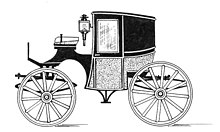Coupé (wagon)
A coupé is a two-axle horse - drawn carriage with a half-closed cabin in which a bench offers seating for two people.
invention
The classic carriage model Coupé was based on the English "Street Cab", which was first called the "Droitschka Chariot". The first use of the city coupe is said to go back to the British politician Henry Brougham, 1st Baron Brougham and Vaux , in 1838. Therefore, in English-language literature, Brougham is sometimes found as a synonym for coupé.
Construction and types
Due to its compact design, the coupé was a very manoeuvrable carriage that still offered comfort. The vehicle was therefore often used as an everyday car by the nobility or the wealthy bourgeoisie . The closed box offers protection from the weather and prying eyes. The upper rounding of the cabin was introduced because this led to noise reduction. The sometimes very annoying background noise in many carriages of this model is caused by loose parts and vibrations. The driver sits high in front of the box above the first axle on a box. It blocks the view of the passengers from the relatively high box to the front, but many carriages are equipped with large side windows. Originally, the coupé was only intended for two people, but in later years types such as the so-called three-quarter coupé were built that also accommodate four people.
literature
- Andres Furger: From a chariot to a city coupé. Carriages and sleighs in Switzerland from the beginnings to the age of the automobile, Neue Zürcher Zeitung, 1993, ISBN 978-3858234025
- Andres Furger: Carriages of Europe in the 19th and 20th centuries, Vol. 1: Equipages-Handbuch, Edition Olms, 2003, ISBN 978-3487084473
- Andres Furger: Carriages of Europe in the 19th and 20th centuries, Vol. 2: Wagen-Atlas, Edition Olms, 2004, ISBN 978-3487084480
- Hans A. Krasensky: Carriages: From the Roman touring car to the modern marathon car. A cultural history, Cadmos, 2004, ISBN 978-3861273998
Individual evidence
- ^ Carriages of Europe in the 19th and 20th centuries 1: Equipage manual: BD 1, by Andres Furger, p. 53f
- ^ Horses under the double-headed eagle: The horse as a carrier of culture in the kingdom of the Habsburgs, by Martin Haller , Hildesheim 2002, p. 136
- ↑ The Luxury Wagon: A Handbook for Equipage Owners, by Carl Gustav Wrangel, 1898, p. 92
